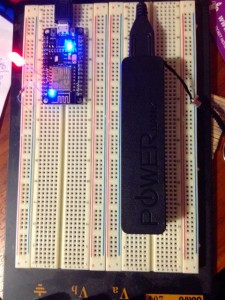I bought a NodeMCU module a while back, but couldn’t figure out how to use it at the time. I also played with one of the ESP8266 modules using a FTDI adaptor to also convert to 3V3, but it seemed rather flaky. In the end, I found I could simply hook up the NodeMCU to a USB port and use the Arduino IDE. To save a whole lot of messing around, I also set up Blynk, which works briliantly with this type of device. One slight complication is that the NodeMCU tries to map pins to equivalent Arduino pinouts, whilst Blynk is still aware of the GPIO pinouts. Finding a pinout diagram here helped make sense of it.

It also seems that the USB ports on my MacBook Pro aren’t reliable with this device, whether it isn’t so happy with USB 3.0 ports or whether it’s not supplying enough current I can’t tell. When it shows up it is easy to flash it with the Arduino sketch. Plugging the board into a phone charger it works 100%. I’m also testing out an el cheapo phone battery booster from K-Mart as a portable power source for projects, and at only $5 this is great value, so I plan to pick up a few more.

Suddenly I see a whole lot of benefits of using these inexpensive NodeMCU boards in place of Arduinos for lightweight projects, considering that you get Wi-Fi built in.